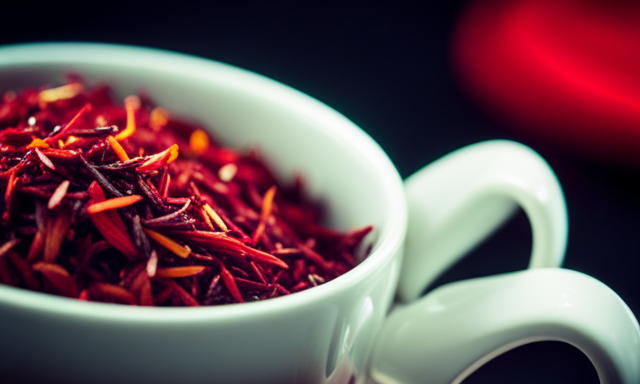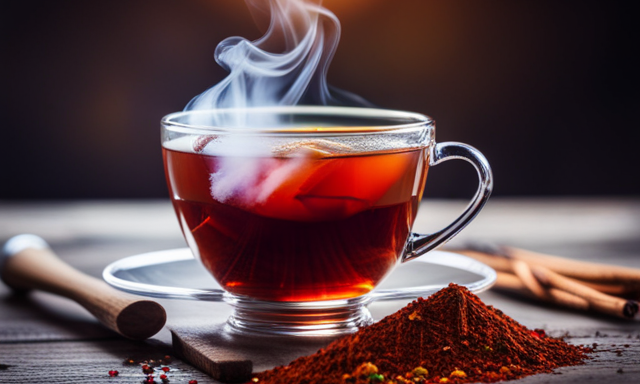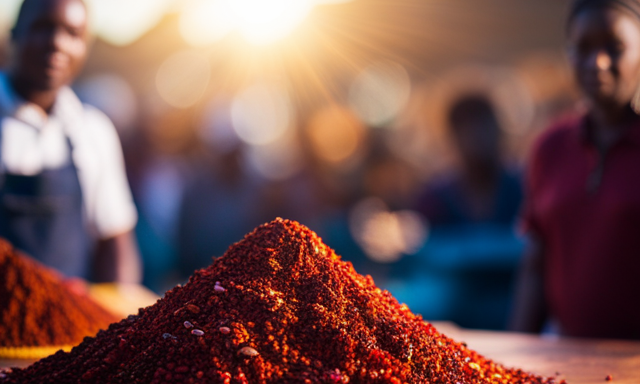Imagine yourself sitting in a cozy café, surrounded by the rich aroma of tea. As you gaze at the menu, your eyes are drawn to the section dedicated to Rooibos tea. You see two options: green and red. The question arises, which one is best? Allow me to be your guide as we embark on a journey to explore the nuances of green and red Rooibos tea.
Rooibos tea, native to South Africa, is known for its smooth taste and numerous health benefits. Green Rooibos tea, lighter in color and flavor, offers a refreshing and grassy taste. On the other hand, red Rooibos tea, with its robust and earthy profile, delivers a comforting and full-bodied experience.
But taste is not the only factor to consider. We will also delve into the caffeine content, brewing techniques, and the sustainability and environmental impact of each variety.
So, grab a cup of tea and join me as we uncover the wonders of green and red Rooibos tea, and ultimately discover which one reigns supreme.
Key Takeaways
- Factors influencing tea preferences include taste bud sensitivity, cultural background, personal memories associated with flavors, and exploration and experimentation with different varieties.
- Green rooibos is a caffeine-free alternative to traditional tea, offering increased alertness and temporary energy boost without the potential jitters and sleep disturbances associated with caffeine.
- Both green and red rooibos tea contain antioxidants that protect against oxidative stress and inflammation, improve heart health, reduce the risk of chronic diseases, and enhance immune function.
- Brewing techniques for green and red rooibos tea differ, with green rooibos requiring a lower brewing temperature and shorter steeping time, resulting in a delicate and slightly sweet flavor, while red rooibos needs boiling water and longer steeping time, resulting in a full-bodied and earthy taste.
What is Rooibos Tea?
Rooibos tea, also known as ‘red bush’ tea, is a delicious and caffeine-free herbal infusion that originates from South Africa. It is made from the leaves of the Aspalathus linearis plant, which is native to the Cederberg region.
Rooibos tea has gained popularity worldwide due to its numerous health benefits. It is rich in antioxidants, such as aspalathin and nothofagin, which help boost the immune system and protect the body against free radicals. Additionally, rooibos tea is known for its anti-inflammatory properties, aiding in digestion and promoting healthy skin.
The tea is also known to be soothing and calming, making it a popular choice for those looking to relax.
Now, let’s explore the benefits of green rooibos tea.
Green Rooibos Tea
When it comes to green rooibos tea, there’s a lot to talk about. Firstly, let’s discuss its unique processing and flavor profile. Unlike red rooibos tea, green rooibos is unfermented, resulting in a lighter and more delicate taste. It has a slightly grassy and herbal flavor, making it a refreshing and soothing choice.
In terms of health benefits, green rooibos tea is packed with antioxidants that can help boost your immune system and support overall well-being. It is also known for its anti-inflammatory properties and can aid in digestion. Plus, it’s naturally caffeine-free, making it a great option for those looking for a caffeine alternative.
When it comes to brewing methods, green rooibos tea is best steeped in hot water for about 5-7 minutes to extract its full flavor. It can be enjoyed hot or cold, and it pairs well with a slice of lemon or a touch of honey.
So whether you’re a tea connoisseur or just looking for a new healthy beverage, green rooibos tea is definitely worth a try.
Processing and flavor profile
If you’re looking for a tea with a unique flavor profile, you can’t go wrong with either green or red rooibos. They both offer a taste that’s like a breath of fresh air.
Green rooibos undergoes a different processing technique compared to its red counterpart. After being harvested, green rooibos is carefully dried to prevent oxidation, preserving its vibrant green color and delicate flavor.
The aroma of green rooibos is subtly grassy with hints of herbs, providing a refreshing and invigorating experience. When compared to red rooibos, the taste of green rooibos is lighter and more vegetal, with a slightly sweet and nutty undertone.
Opting for green rooibos allows you to experience a different aspect of rooibos tea, adding variety to your tea collection.
Moving onto health benefits and antioxidants, these teas have much to offer in terms of promoting well-being and boosting your immune system.
Health benefits and antioxidants
Indulge in the delightful benefits of these teas, as they offer a plethora of health benefits and antioxidants to boost your overall well-being.
When it comes to health benefits, both green and red rooibos teas have their own unique advantages. Green rooibos tea is known for its high levels of antioxidants, which can help fight off free radicals and reduce the risk of chronic diseases. On the other hand, red rooibos tea is rich in minerals like calcium, magnesium, and potassium, which promote bone health and aid in digestion.
While green rooibos tea has a lighter taste profile, red rooibos tea offers a richer and sweeter flavor. When comparing caffeine content, green rooibos tea is naturally caffeine-free, making it a great alternative for those seeking a caffeine-free option.
Additionally, both green and red rooibos teas are sustainable choices, as they are harvested from the same plant and require minimal water usage.
Transitioning to the subsequent section about ‘best brewing methods and serving suggestions,’ let’s explore the optimal ways to enjoy these teas to their fullest potential.
Best brewing methods and serving suggestions
To fully savor the delightful flavors of these teas and enhance your overall experience, let’s explore the optimal brewing techniques and serving suggestions. Here are some key considerations when preparing green or red rooibos tea:
-
Brewing temperature: Both green and red rooibos tea should be brewed with water that is heated to around 200°F (93°C). This temperature allows for the extraction of the tea’s flavors without causing any bitterness.
-
Steeping time: Green rooibos tea should be steeped for about 5 minutes, while red rooibos tea can be steeped for a longer period, around 7-10 minutes. This duration ensures that the full range of flavors and antioxidants are released.
-
Serving suggestions: Green rooibos tea is best enjoyed hot, while red rooibos tea can be served hot or cold. You can also add a slice of lemon or a drizzle of honey to enhance the taste.
Now, let’s delve into the unique characteristics and benefits of red rooibos tea.
Red Rooibos Tea
Choose red rooibos tea for a soothing and satisfying beverage that will leave you feeling refreshed and invigorated.
When it comes to brewing techniques, the best method for red rooibos tea is to steep it in boiling water for 5-7 minutes. This allows the flavors to fully develop and ensures a rich and robust taste.
Unlike green rooibos tea, red rooibos is oxidized, giving it a deeper and more intense flavor profile. It has a naturally sweet and earthy taste with hints of vanilla and caramel.
The flavor of red rooibos tea is distinct and delightful, making it a popular choice among tea enthusiasts.
In the next section, we will explore the taste comparison between red and green rooibos tea, highlighting the unique qualities of each.
Taste Comparison
When it comes to the taste comparison between green and red rooibos tea, the flavor profiles are quite distinct.
Green rooibos tea has a lighter and more delicate taste, with a subtle grassy and herbal flavor.
On the other hand, red rooibos tea has a richer and sweeter taste, with notes of caramel and vanilla.
Personal preferences play a big role in determining which tea one might prefer, as some may enjoy the refreshing and mild flavor of green rooibos, while others may prefer the bold and sweet taste of red rooibos.
Ultimately, the sensory experience of drinking either tea is a personal one, with each sip providing a unique and enjoyable experience.
Flavor profile of green and red rooibos tea
If you think the flavor of green rooibos tea is anything less than amazing, you must have a taste bud deficiency. Green rooibos tea offers a delicate and refreshing taste that is distinct from its red counterpart.
Compared to black rooibos, green rooibos has a milder and slightly sweet flavor. It has subtle grassy notes with hints of honey and citrus, making it a perfect choice for those who enjoy a lighter and more nuanced taste.
The flavor profile of green rooibos is often described as smooth, clean, and naturally sweet, without the earthy undertones found in red rooibos. Personal preferences and sensory experiences play a significant role in determining one’s preference between green and red rooibos tea.
Transitioning into the next section, understanding these flavor profiles will help in making an informed decision based on individual taste preferences and sensory experiences.
Personal preferences and sensory experience
Now let’s dive into the world of personal preferences and sensory experience when it comes to green and red rooibos tea.
Different varieties of rooibos tea offer unique flavor profiles and aromas, which play a significant role in determining our preference. Some may prefer the earthy and slightly sweet taste of red rooibos, while others may lean towards the grassy and slightly vegetal notes of green rooibos.
Factors influencing personal preferences in tea selection can vary from individual to individual, including taste buds sensitivity, cultural background, and even personal memories associated with certain flavors. Exploring and experimenting with different varieties can help us discover our own unique preferences.
Now, let’s move on to the next section about caffeine content and its impact on our tea-drinking experience.
Caffeine Content
Additionally, it’s important to consider the caffeine content when deciding between green and red rooibos tea. While both types of tea are naturally caffeine-free, green rooibos tea is often preferred by those looking for a caffeine alternative. Caffeine can have various effects on the body, such as increased alertness and temporary energy boost, but it can also lead to jitters and sleep disturbances for some individuals. Green rooibos tea provides a great option for those who want to enjoy the taste and experience of tea without the stimulating effects of caffeine. To further understand the caffeine content in green and red rooibos tea, refer to the table below:
| Tea Type | Caffeine Content |
|---|---|
| Green Rooibos | Caffeine-free |
| Red Rooibos | Caffeine-free |
Considering the caffeine content, it’s evident that both green and red rooibos teas are excellent choices for those seeking caffeine alternatives. Moving forward, let’s explore the health benefits of these teas.
Health Benefits
One can savor the delightful health benefits that these teas offer.
Scientific studies on health benefits have shown that both green and red rooibos tea contain a variety of antioxidants, such as aspalathin and quercetin, which can help protect the body against oxidative stress and reduce inflammation. These antioxidants have been linked to potential health benefits, including improved heart health, reduced risk of chronic diseases, and enhanced immune function.
Additionally, both teas have a long history of traditional uses in herbal medicine. They have been used to alleviate digestive issues, promote relaxation, and support overall well-being.
Transitioning into the subsequent section about ‘brewing techniques,’ it is important to understand the optimal methods for preparing and enjoying these teas to fully experience their remarkable flavors and health benefits.
Brewing Techniques
To fully savor the remarkable flavors and health benefits of these teas, let us delve into the art of brewing them to perfection. When it comes to brewing green or red rooibos tea, the key lies in the right brewing temperature and steeping time.
For green rooibos, it is best to use water that is around 176°F (80°C) and steep it for about 3-5 minutes. This ensures a delicate and slightly sweet flavor.
On the other hand, red rooibos should be brewed with water at a rolling boil, around 212°F (100°C), and steeped for 5-7 minutes to unlock its full-bodied and earthy taste.
With these brewing techniques, you can create a cup of rooibos tea that is bursting with flavor and goodness.
Moving on to sustainability and environmental impact, it is important to consider the production methods and ethical practices behind these teas.
Sustainability and Environmental Impact
Explore the fascinating world of sustainability and the impact on the environment when it comes to brewing and enjoying these remarkable teas. Sustainable farming practices are crucial for both green and red rooibos teas. Farmers who prioritize sustainable practices use organic and natural methods to cultivate the tea leaves, avoiding harmful pesticides and chemicals. This not only ensures a healthier product but also protects the environment. Additionally, eco-friendly packaging plays a significant role in reducing waste and carbon footprint. Many companies now offer tea bags made from biodegradable materials or loose leaf options that eliminate the need for excessive packaging. By choosing sustainably produced teas and eco-friendly packaging, we can enjoy our cup of rooibos guilt-free, knowing that we are supporting practices that prioritize the health of our planet. Now, let’s move on to the exciting world of recipes and culinary uses.
Recipes and Culinary Uses
Discover a multitude of delicious recipes and creative ways to incorporate this versatile and flavorful ingredient into your culinary creations.
Green and red rooibos tea can be used in a variety of recipes, adding a unique twist to both sweet and savory dishes. For a refreshing twist on a classic, try making rooibos-infused iced tea with a hint of lemon and honey.
You can also use rooibos tea as a base for marinades and dressings, giving your meats and salads a subtle earthy flavor.
In terms of health benefits, both green and red rooibos tea are packed with antioxidants and have been linked to improved digestion and reduced inflammation. They are also caffeine-free, making them a great option for those looking to limit their caffeine intake.
Transitioning into the next section, let’s delve into the conclusion and my personal recommendation for the best rooibos tea option.
Conclusion and Personal Recommendation
Now that we have explored the various recipes and culinary uses of both green and red rooibos tea, it is time to reach a conclusion and offer my personal recommendation.
When it comes to choosing between green and red rooibos tea, it ultimately boils down to personal preferences. The sensory experience of each tea is unique, with green rooibos offering a slightly grassy and herbal flavor, while red rooibos has a sweeter and nuttier taste.
Additionally, it is worth considering the caffeine content, with green rooibos containing a small amount of naturally occurring caffeine, whereas red rooibos is caffeine-free.
Both teas offer numerous health benefits and can be brewed using similar techniques. However, in terms of sustainability and environmental impact, red rooibos is the better choice as it is only grown in one region, reducing transportation emissions.
Ultimately, I would recommend trying both teas and deciding based on your personal preferences and values.
Frequently Asked Questions
Are there any potential side effects or allergies associated with drinking rooibos tea?
There are no known side effects or allergies associated with drinking rooibos tea. Additionally, research suggests that rooibos tea may help lower blood pressure due to its antioxidant properties.
How does the price of green rooibos tea compare to red rooibos tea?
How does the price of green rooibos tea compare to red rooibos tea? Is green rooibos worth the extra cost? Green rooibos tends to be slightly more expensive, but its benefits, such as higher antioxidants, make it worth considering.
Can rooibos tea be enjoyed hot and cold?
Rooibos tea can be enjoyed both hot and cold. When consumed hot, it provides a soothing and comforting experience, while when served cold, it becomes a refreshing and thirst-quenching beverage. Additionally, rooibos tea boasts numerous health benefits, making it a great choice for any time of the day.
Is it safe for pregnant women to drink rooibos tea?
During pregnancy, it is generally safe to drink rooibos tea. It is caffeine-free and rich in antioxidants, which can promote overall health. However, it’s always best to consult with a healthcare professional for personalized advice.
Can rooibos tea be used in skincare products?
I recently tried a DIY rooibos tea face mask and was amazed by the benefits for my skin. Incorporating rooibos tea in your skincare routine can provide antioxidants, soothe irritation, and promote a healthy, glowing complexion.
Conclusion
After carefully comparing the taste, caffeine content, brewing techniques, sustainability, and culinary uses of green and red rooibos tea, I have come to a conclusion.
While both variants have their own unique qualities, I personally recommend red rooibos tea. Its rich and robust flavor, reminiscent of a warm embrace on a chilly evening, leaves a lasting impression.
Additionally, its higher antioxidant content and soothing properties make it a perfect choice for relaxation and overall well-being.
So, indulge in a cup of red rooibos tea and let its comforting embrace transport you to a world of tranquility.










